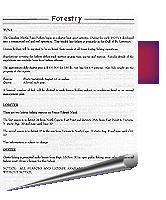
 Prince
Edward Island’s forests are part of the Acadian
Forest region that includes much of the Northeastern
United States and Eastern and Atlantic regions of Canada.
This area is part of the North American Transition Forest
Zone, where the northern Boreal Forest overlaps with
southern Deciduous Forests. As recently as 250 years ago,
Prince Edward Island was virtually covered in Acadian
Forest that supported a diverse animal population,
including bears and moose. Hardwoods thrived in the
upland areas and in sections of high-quality soil.
Conifers were more abundant in poorly drained areas,
along the coast, and in areas disturbed by fire, insects,
or disease.
Prince
Edward Island’s forests are part of the Acadian
Forest region that includes much of the Northeastern
United States and Eastern and Atlantic regions of Canada.
This area is part of the North American Transition Forest
Zone, where the northern Boreal Forest overlaps with
southern Deciduous Forests. As recently as 250 years ago,
Prince Edward Island was virtually covered in Acadian
Forest that supported a diverse animal population,
including bears and moose. Hardwoods thrived in the
upland areas and in sections of high-quality soil.
Conifers were more abundant in poorly drained areas,
along the coast, and in areas disturbed by fire, insects,
or disease. With European settlement, the development of agriculture and the shipbuilding boom in the early half of the nineteenth century brought about the extensive harvesting of Island forests. By 1900, only 30 percent of the province was forest covered. Today, forest covers approximately 48 percent of the Island’s land area. The remaining forest far from resembles the original “virgin” Acadian forest inhabited by the Mi’kmaq before European colonization. Indeed, only a few scattered remnants of old growth forest remain. Today’s forest, in ecological terms, is early successional, even-aged, and unable to regenerate itself without intervention and investment. All forested areas have been harvested at least once and many have been cut numerous times.
Eighty-eight percent of the Island’s forests are privately owned, shared by some 16,000 private woodlots. These woodlots have an average size of 18 hectares (44 acres). Private owners manage their woodlots using silviculture techniques and sell their standing wood as stumpage. The wood is harvested using selective (handsaws) or clear-cut (feller-buncher) techniques.
Forestry has contributed to the Island’s economy since its first days of settlement. The forestry industry provides direct and indirect employment for 1,450 Islanders and contributes an annual $14.5 million to the province’s economy. Forestry-related jobs are in harvesting, trucking, sawmilling, manufacturing, forest management, and reforestation as well as in the eco-tourism sector—bird-watching, hiking, and photography. There is also a small amount of maple syrup production for commercial markets.
Christmas Trade
It’s not really Christmas unless your house is filled with the fresh fragrance of fir—a freshly cut balsam fir grown on an Island Christmas tree farm.
Demonstration Woodlots
Designed to provide private woodlot owners and citizens with an opportunity to learn about silviculture techniques and woodlot management, Prince Edward Island’s demonstration woodlots are also a great recreational resource.
Wood Products
Prince Edward Island’s wood manufacturing sector started with a boom—in the early 1800s, Island-built wooden ships sailed the world over. Today, Island trees find their way into our lives in more common ways as they are used in the construction of homes, furniture, tools, crafts, and art.